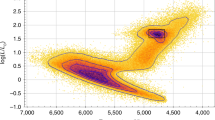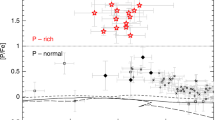Abstract
About half of the stable nuclei heavier than iron are believed to be synthesized during the late stages of evolution of stars with masses in the range 0.8–8 solar masses. These elements are then expelled into the interstellar medium through stellar winds after being ‘dredged up’ towards the surface of the stars. These processes occur when the star is in the ‘asymptotic giant branch’ (AGB) phase of its life. Nuclei (mainly iron) deep inside the star slowly capture neutrons and progressively build up heavier elements (the ‘s-process’). For AGB stars that formed early in the history of the Galaxy, and that therefore have very low abundances of elements heavier than helium (‘metals’), models1 predict that the s-process will accumulate synthesized material with atomic weights in the Pb–Bi region. Such stars will therefore have large overabundances of lead relative to other heavy elements. Here we report the discovery of large amounts of lead in three metal-poor stars (HD187861, HD196944 and HD224959). Our analysis shows that these stars are more enriched in lead than in any other element heavier than iron. The excellent agreement between the observed and predicted abundances reinforces our current understanding of the detailed operation of the s-process deep in the interiors of AGB stars.
This is a preview of subscription content, access via your institution
Access options
Subscribe to this journal
Receive 51 print issues and online access
$199.00 per year
only $3.90 per issue
Buy this article
- Purchase on Springer Link
- Instant access to full article PDF
Prices may be subject to local taxes which are calculated during checkout


Similar content being viewed by others
References
Goriely, S. & Mowlavi, N. Neutron-capture nucleosynthesis in AGB stars. Astron. Astrophys. 362, 599–614 (2000).
Gallino, R. et al. Evolution and nucleosynthesis in low-mass asymptotic giant branch stars. II. Neutron capture and the s-process. Astrophys. J. 497, 388–403 (1998).
Herwig, F., Blöcker, T., Schönberner, D. & El Eid, M. Stellar evolution of low and intermediate-mass stars. IV. Hydrodynamically-based overshoot and nucleosynthesis in AGB stars. Astron. Astrophys. 324, L81–L84 (1997).
Langer, N., Heger, A., Wellstein, S. & Herwig, F. Mixing and nucleosynthesis in rotating TP-AGB stars. Astron. Astrophys. 346, L37–L40 (1999).
Sneden, C., Cowan, J. J., Burris, D. L. & Truran, J. W. Hubble Space Telescope observations of neutron-capture elements in very metal-poor stars. Astrophys. J. 495, 235–245 (1998).
Sneden, C. et al. Evidence of multiple r-process sites in the early Galaxy: New observations of CS 22892-052. Astrophys. J. 533, L139–L142 (2000).
Aoki, W., Norris, J. E., Ryan, S. G., Beers, T. C. & Ando, H. Detection of lead in the carbon-rich, very metal-poor star LP 625-44: A strong constraint on s-process nucleosynthesis at low metallicity. Astrophys. J. 536, L97–L100 (2000).
Goriely, S. & Clerbaux, B. Uncertainties in the Th cosmochronometry. Astron. Astrophys. 346, 798–804 (1999).
McClure, R. D. & Woodsworth, A. W. The binary nature of the barium and CH stars. III. Orbital parameters. Astrophys. J. 352, 709–723 (1990).
Fujimoto, M. Y., Ikeda, Y. & Iben, L. Jr. The origin of extremely metal-poor carbon stars and the search for population III. Astrophys. J. 529, L25–L28 (2000).
Käppeler, F., Beer, H. & Wisshak, K. s-Process nucleosynthesis—nuclear physics and the classical model. Rep. Prog. Phys. 52, 945–1013 (1989).
Travaglio, C., Galli, D., Gallino, R., Busso, M., Ferrini, F. & Straniero, O. Galactic chemical evolution of heavy elements: From barium to europium. Astrophys. J. 521, 691–702 (1999).
Zac̆s, L., Nissen, P. E. & Schuster, W. J. The chemical composition of HD 196944: a carbon and s-process rich, very metal-poor star. Astron. Astrophys. 337, 216–222 (1998).
Vanture, A. D. The CH stars. III. Heavy element abundances. Astron. J. 104, 1997–2004 (1992).
Alvarez, R. & Plez, B. Near-infrared narrow-band photometry of M-giant and Mira stars: models meet observations. Astron. Astrophys. 330, 1109–1119 (1998).
Biémont, E., Garnir, H. P., Palmeri, P., Li, Z. S. & Svanberg, S. New f-values in neutral lead obtained by time-resolved laser spectroscopy, and astrophysical applications. Mon. Not. R. Astron. Soc. 312, 116–122 (2000).
Luque, J. & Crosley, D. R. LIFBASE: database and spectral simulation program. SRI International Report MP 99-009 (1999) available at http://www.sri.com/psd/lifbase.
Acknowledgements
We thank R. Alvarez, M. Arnould and V. Hill for help and advice. S.G. and A.J. are FNRS Research Associates. S.V. is an FNRS Post-doctoral Researcher. This work is based on observations carried out at the European Southern Observatory in Chile.
Author information
Authors and Affiliations
Corresponding author
Rights and permissions
About this article
Cite this article
Van Eck, S., Goriely, S., Jorissen, A. et al. Discovery of three lead-rich stars. Nature 412, 793–795 (2001). https://doi.org/10.1038/35090514
Received:
Accepted:
Issue Date:
DOI: https://doi.org/10.1038/35090514
This article is cited by
-
Heavy elements
Experimental Astronomy (2023)
-
The temperature and chronology of heavy-element synthesis in low-mass stars
Nature (2015)
-
Carbon stars
Journal of Astrophysics and Astronomy (2010)
Comments
By submitting a comment you agree to abide by our Terms and Community Guidelines. If you find something abusive or that does not comply with our terms or guidelines please flag it as inappropriate.



